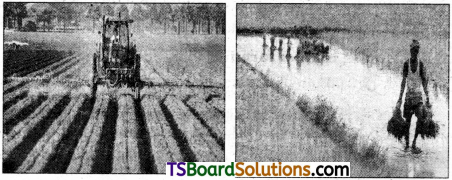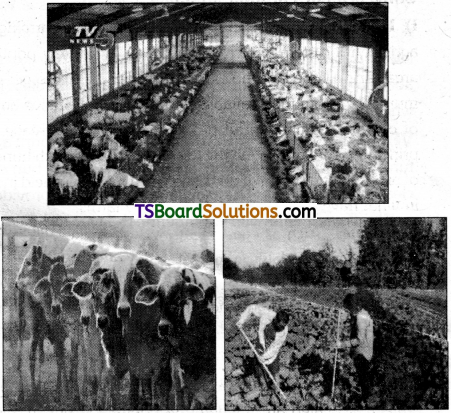Telangana TSBIE TS Inter 1st Year Ethics and Human Values Study Material 9th Lesson Ethics in Social Media and Technology Textbook Questions and Answers.
TS Inter 1st Year Ethics and Human Values Study Material 9th Lesson Ethics in Social Media and Technology
Question 1.
Describe some of the advantages and disadvantages of the internet.
Answer:
Uses of Internet:
i) Availability of the Vast Resource :
The information that is accessible on the Internet is practically infinite. Whether in the field of sciences, humanities, fine arts or medicine. One need not go to library now a days. More books are readily accessible at the click of the mouse in all fileds.
ii) Instant and Easy Access to Information :
It takes just seconds for a website to open and, within minutes, one can go through several websites in search of the information that is needed.
iii) Effortless communication with Friends and Family :
Letter writing, posting, and delivering of letters has been replaced by instant, hassle-free “e-mail”. E-mail means electronic mail.
iv) Easy Interaction with unknown Person :
Networking sites on the Internet enable us to chat with family members and unknown persons also. There are several forums on the Internet for people sharing common interests.
v) Source of Endless Entertainment :
With the use of the Internet, we can listen to music and watch movies and TV shows. Besides, we can also play online games. These games may be action or adventure games, board games, racing games, puzzle games, skill games.
vi) Flexi Work and Easy Transfer of Data :
It is no longer necessary to follow rigid timings of work in the office. Work can be completed at home on a computer and reports, bulky data, files, etc can be transmitted to any corner of the earth in seconds.
vii) Applications in Banking and Finance :
Internet banking has made it possible to pay utility and other bills online, transfer money from one account to another and conduct financial transactions like the buying and selling of shares.
We can book railway, bus, and aeroplane tickets, make hotel bookings and give donations to an organization without leaving home.
Drawbacks of the Internet and Misuse among Youth :
i) Excessive dependence on Technology and Addiction :
The Internet is not only a substitute for a library, but doubles up as a TV, a phone, a music provider and a medium to play games and interact with friends. Youngsters, especially in western countries, spend a lot of time on the Internet. The extent of dependence on the Internet can be alarming at times. It may border on addiction.
ii) Disconnect with the Real world :
Youngsters are so immersed in the virtual world that they are losing connection with the real world in which they live. They spend hours together browsing the web, playing online games and being active on social networking sites.
iii) Loss of Skills :
In advanced countries, people are accustomed to using their laptop from a tender age and, as a result, rarely have an occasion to practice hand writing.
iv) Break down of Family Ties :
Present-day adolescents spend so much time on the Internet that the time they spend with family members is decreasing day by day. Even at dinner, the teenager is constantly checking mails.
v) Inability to communicate in the Real Social World :
It cannot be denied that social networking sites enable us to make friends with total strangers and stay in touch with family and friends living far away.
vi) Blurring of distinctions between Office time and Home time :
It might be convenient to work at home, either part-time or full-time, but sometimes family life is affected adversely.
vii) Unethical usage of the Internet :
Students often “copy” and “paste” chunks of information found on the Internet and do not bother even to acknowledge the source when submitting assignments. It is also becoming increasingly common to use blue tooth devices for malpractices in the examination hall with help from experts who supply the answers from outside.
ix) Easy access to Indecent Sites :
Youngsters have easy access to sites which may contain indecent movies. The ready availa¬bility of pornography is a matter of grave concern. It may not be a coincidence that some of the most brutal crimes against women have taken place in the recent past in India soon after the juvenile criminals viewed pornography.
x) Information on the Internet may be Inaccurate :
The information available on websites may not always be accurate and may need to be cross checked.
![]()
Question 2.
List out some guidelines for youngsters regarding the proper and judicious use of the internet.
Answer:
Guidelines for the use of the Internet by Teens :
- Teenagers should spend only a limited amount of time on their computer. A computer cannot be a substitute for a friend or family member.
- Teenages should spend time outdoors in games and social interaction with friends and family. They should not remain cooped up in their home with laptops during holidays.
- Teenagers should use the Internet mostly for information and partly for recreation. They should make ethical use of the infor- mation on the web.
- Teenagers should have a frank discussion with their parents about various aspects of Internet usage, such as amount of time spent daily on the net, timings and purpose.
- Teenagers should agree to parental supervision and frequent checks of what they have been surfing or doing on the net.
- Teenagers should promise not to visit sites that are not suitable for them. They should avoid sites that are indecent and which contain ‘adult content’.
- Passwords should NEVER be revealed to anyone, except to parents. They should not be shared even with friends.
- Photos should NEVER be shared with strangers.
- Teenagers should avoid meeting online acquaintances except with parental approval.
- Teenagers should immediately inform parents if anything inappropriate or odd takes place while interacting with others on social networks.
- E-mails from unknown persons should not be opened as they may contain spam and unsolicited messages. Anti-virus software should be installed.
- Credit cards of parents should not be used without prior permission to buy goods online. Good should be bought only from reliable sites.
- Teenagers should observe ‘netiquette’. They should.be polite and should avoid posting mean or nasty comments.
- Laptops should be used carefully. When their life is over they should be handed over at a place for recycling e-waste.
![]()
Question 3.
Your friend has bought her first mobile phone and is asking you for some general advice about the usage of mobile phones. How would you guide her?
Answer:
- Teenagers should remember that the primary purpose of a mobile phone is to stay in touch with the family. They should yield to peer pressure or make comparisons with those who have fancy gadgets. They should not force parents to buy them expensive phones.
- Teenagers should discuss with their parents the amount of time they can use the phone daily and the expense involved. They should keep within those limits.
- Mobile phones should not be used in class. They should either be switched off or kept in silent mode.
- It is impolite and discourteous to talk loudly over the phone in public places such as movie halls, restaurants, malls and trains.
- Talking over the mobile, checking mail and sending messages should be completely avoided during formal occasions such as meetings.
- Talking on the phone while driving, even on Bluetooth, is dangerous and also illegal in most countries. Texting while driving is doubly so.
- Youngsters should avoid too much texting on the mobile. Excessive texting results invariably in the excessive use of abbreviations. After a while even spoken and written language gets distorted.
- The use of the phone should be avoided while the battery is being charged as there have been instances of spurious batteries exploding.
- It is advisable to speak not more than half an hour on the mobile everyday. Mobile phones like laptops, electric hair driers and shavers emit electro magnetic radiation. Some scientific studies have linked the excessive use of talking on mobile phones with a greater incidence of headaches, stress and even brain tumours.
- It is rude to look into the messages of others or even their list of contacts without their permission.
- It is advisable to use a password for opening the phone. If the phone is lost the mobile service provider should be informed at once and a police complaint too should be lodged. There have been several instances when stolen SIM cards have been used for criminal purposes.
- Back up all data such as contacts and photos on a pendrive or as a hard copy on your computer.
- If the mobile is a “smart phone” and has Internet connectivity, all the guidelines related to the proper use of the Internet should be observed.
- Avoid using the smart phone for banking and other sensitive transactions in public places having wireless connectivity as data can be compromised.
![]()
Question 4.
Describe how privacy and personal safety can be compromised unknowingly by users of the internet. What precautions should one take to avoid becoming a victim of cyber crime?
Answer:
There are many risks involved in visiting social networking sites. Novices to the Internet may not be even aware of these risks. Cyber crimes are steadily increasing by the day and result sometimes in the loss of one’s entire savings and even, occasionally, loss of life.
- Teenagers should remember that the primary purpose of social networking sites is to stay in touch with friends and family.
- They should not make friends with strangers or people who promise lucrative jobs like modelling careers or movie roles.
- Teenagers should discuss with their parents if anyone un – known tries to make “friends” with them on a social net working site.
- Social networking sites should not be used to post offensive messages about friends or to gossip about others.
- Personal d fails like address and telephone number and passwords should never be revealed on social networking sites.






